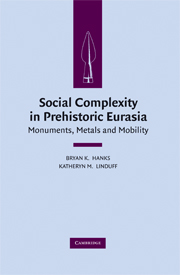Book contents
- Frontmatter
- Contents
- Contributors
- Foreword: From Myth to Method: Advances in the Archaeology of the Eurasian Steppe
- CHAPTER 1 Introduction: Reconsidering Steppe Social Complexity within World Prehistory
- PART ONE FRAMING COMPLEXITY
- CHAPTER 2 Introduction
- CHAPTER 3 Differentiated Landscapes and Non-uniform Complexity among Bronze Age Societies of the Eurasian Steppe
- CHAPTER 4 The Sintashta Genesis: The Roles of Climate Change, Warfare, and Long-Distance Trade
- CHAPTER 5 Settlements and Cemeteries of the Bronze Age of the Urals: The Potential for Reconstructing Early Social Dynamics
- CHAPTER 6 The Maikop Singularity: The Unequal Accumulation of Wealth on the Bronze Age Eurasian Steppe?
- PART TWO MINING, METALLURGY, AND TRADE
- PART THREE FRONTIERS AND BORDER DYNAMICS
- PART FOUR SOCIAL POWER, MONUMENTALITY, AND MOBILITY
- Index
CHAPTER 6 - The Maikop Singularity: The Unequal Accumulation of Wealth on the Bronze Age Eurasian Steppe?
from PART ONE - FRAMING COMPLEXITY
Published online by Cambridge University Press: 26 January 2010
- Frontmatter
- Contents
- Contributors
- Foreword: From Myth to Method: Advances in the Archaeology of the Eurasian Steppe
- CHAPTER 1 Introduction: Reconsidering Steppe Social Complexity within World Prehistory
- PART ONE FRAMING COMPLEXITY
- CHAPTER 2 Introduction
- CHAPTER 3 Differentiated Landscapes and Non-uniform Complexity among Bronze Age Societies of the Eurasian Steppe
- CHAPTER 4 The Sintashta Genesis: The Roles of Climate Change, Warfare, and Long-Distance Trade
- CHAPTER 5 Settlements and Cemeteries of the Bronze Age of the Urals: The Potential for Reconstructing Early Social Dynamics
- CHAPTER 6 The Maikop Singularity: The Unequal Accumulation of Wealth on the Bronze Age Eurasian Steppe?
- PART TWO MINING, METALLURGY, AND TRADE
- PART THREE FRONTIERS AND BORDER DYNAMICS
- PART FOUR SOCIAL POWER, MONUMENTALITY, AND MOBILITY
- Index
Summary
In 1897 N. I. Veselovskii excavated the very large, nearly 11 meter high Oshad kurgan or barrow in the town of Maikop in the Kuban region near the foothills of the northwestern Caucasus (the present-day capital of the Adygei Republic). The kurgan contained a spectacularly rich burial assemblage, including bronze weapons and cauldrons; scores of figured gold appliqués, which had been sewn on the clothes of the principal male burial; six silver rods (some more than a meter long) with gold and silver terminals depicting bulls (Fig. 6.1); silver, gold, stone, and ceramic vessels; and numerous turquoise and carnelian beads. This discovery stimulated the excavation of other large kurgans located in the same general region, some of which seemed royal-like in their dimensions and, when not robbed in antiquity, in their materials. This research has continued to the present day and spectacular discoveries are still being unearthed, such as hoards from the Klady kurgan necropolis near the village of Novosvobodnaya that have been excavated from 1979 on (Rezepkin 2000), containing distinct but clearly Maikop-related bronze, gold, silver, polished stone, ceramic, turquoise, and carnelian artifacts.
The Maikop materials were initially brought to the attention of Western scholars through the writings of A. M. Tallgren, M. I. Rostovtseff, and, later, V. G. Childe. The absolute dating of these large kurgans was debated for years, with some scholars (Degen-Kovalevskii 1939, cited in Munchaev 1994 : 159–160) relating them to the Scythians or immediately pre-Scythians and dating them as late as the early first millennium bce, while most (Iessen 1950) dated them back to the middle to second half of the third millennium bce.
- Type
- Chapter
- Information
- Social Complexity in Prehistoric EurasiaMonuments, Metals and Mobility, pp. 91 - 104Publisher: Cambridge University PressPrint publication year: 2009
- 2
- Cited by

